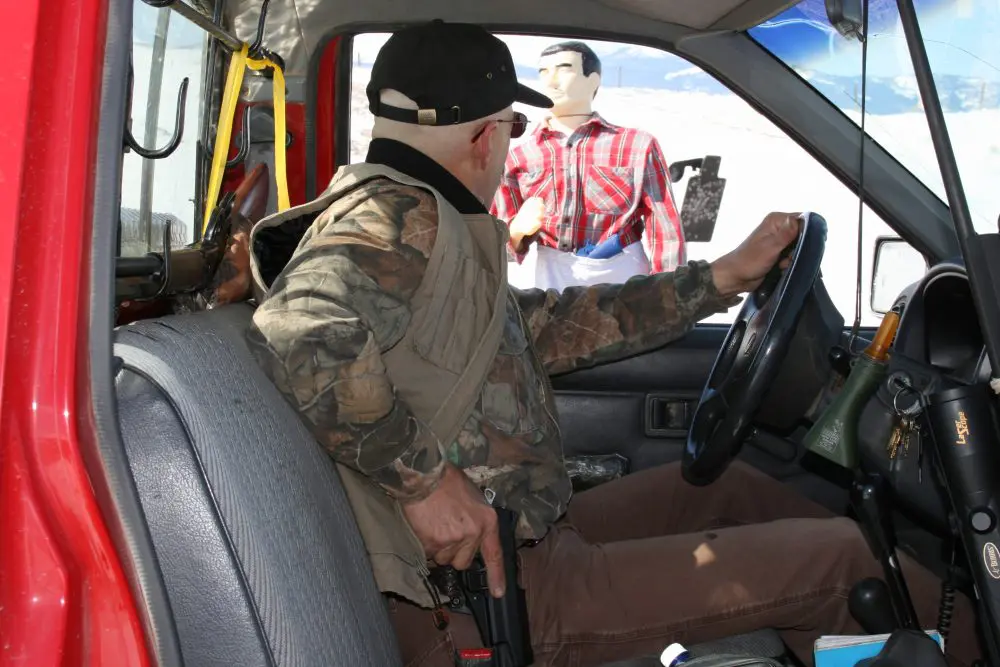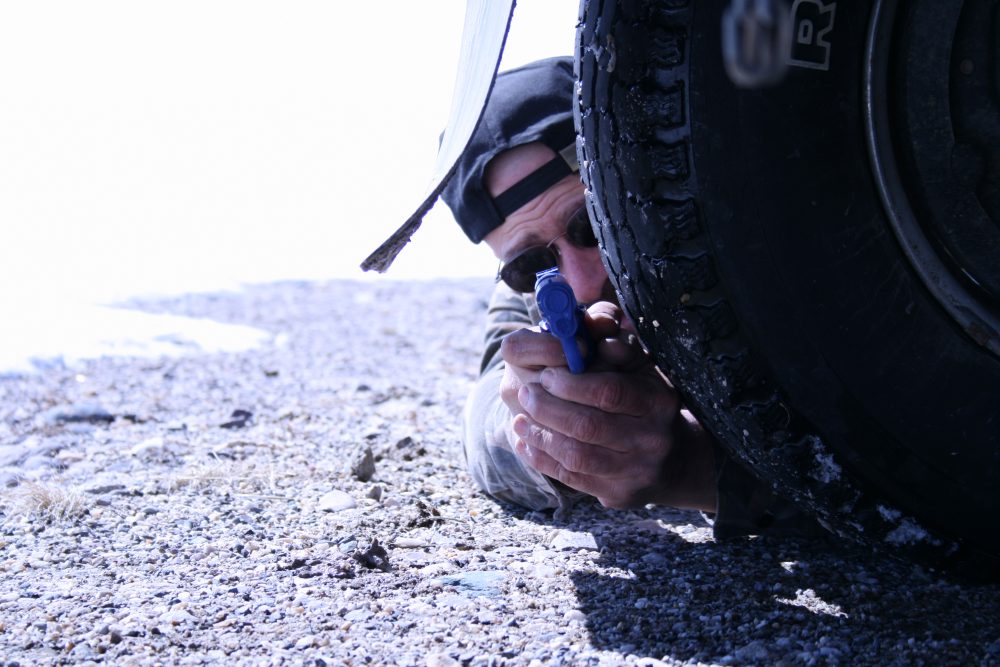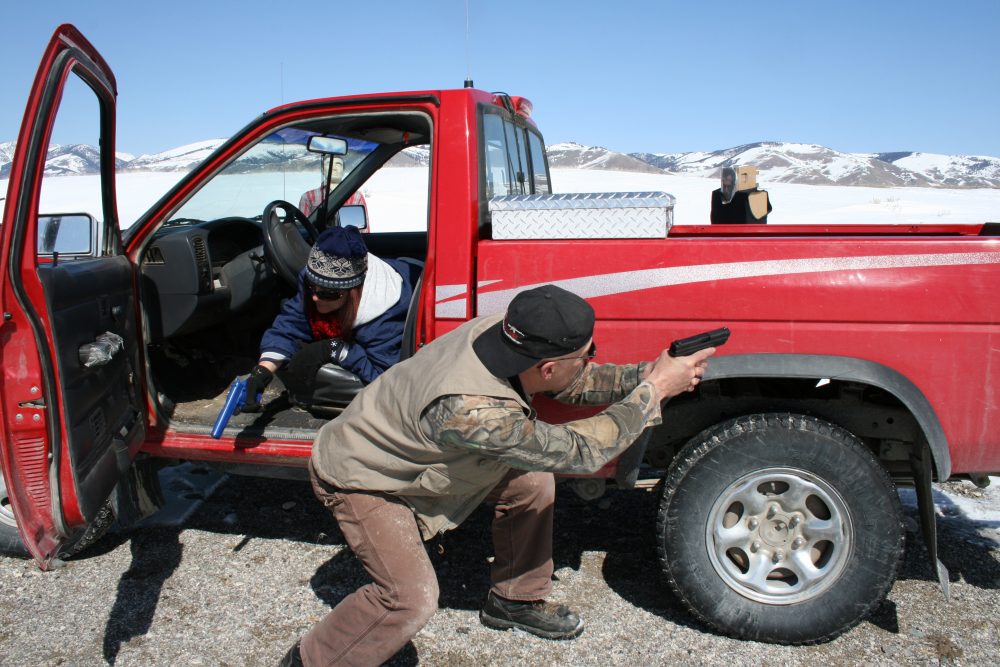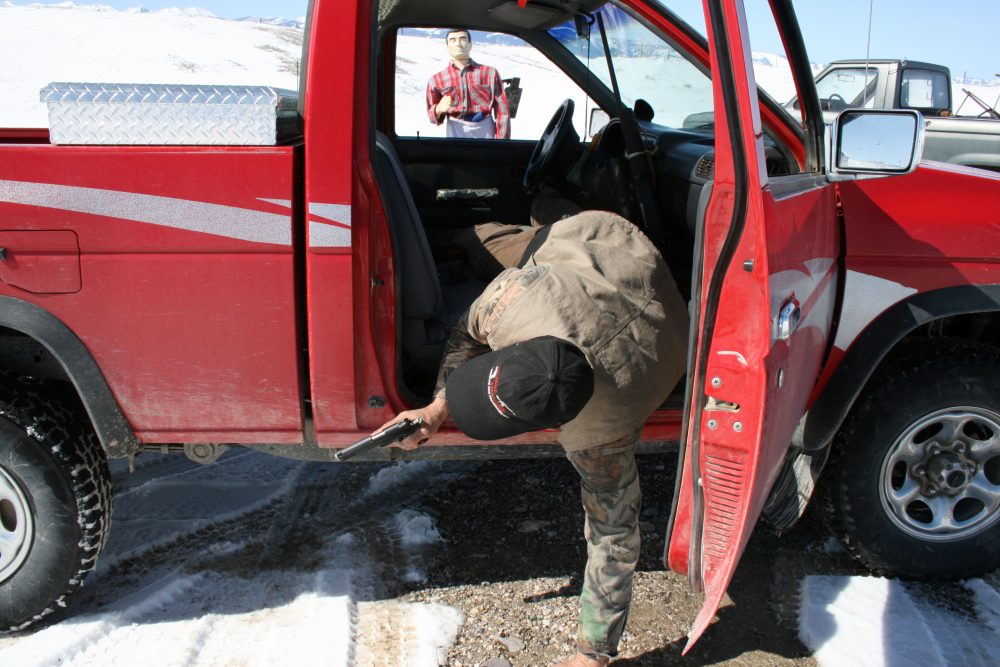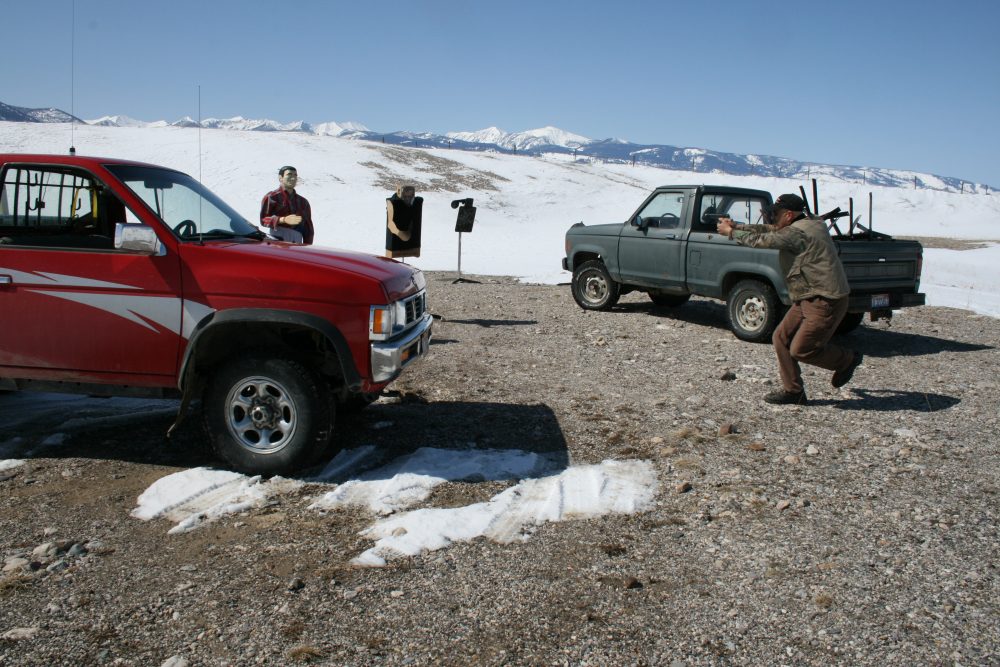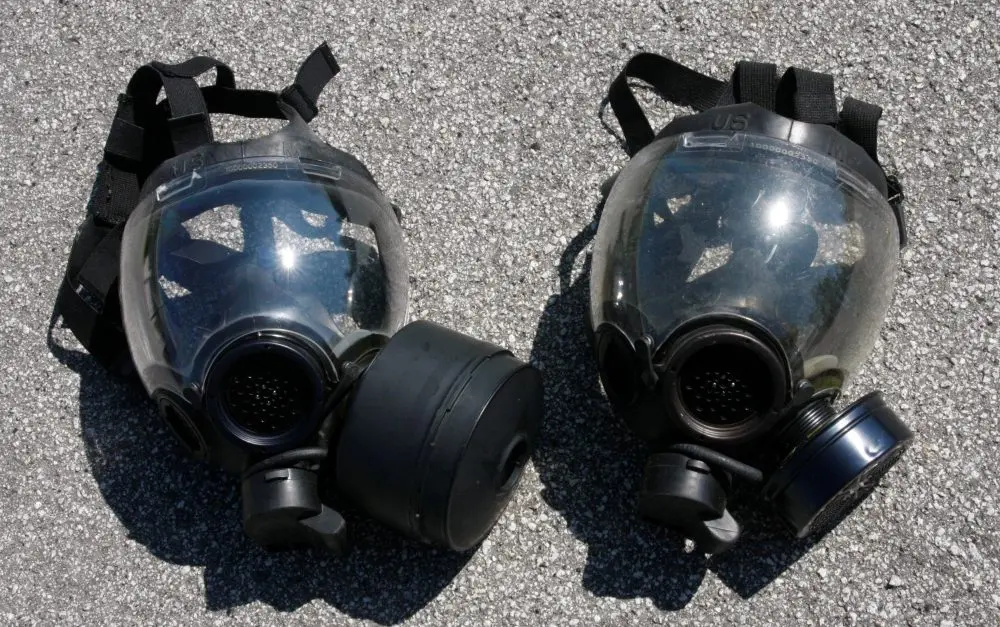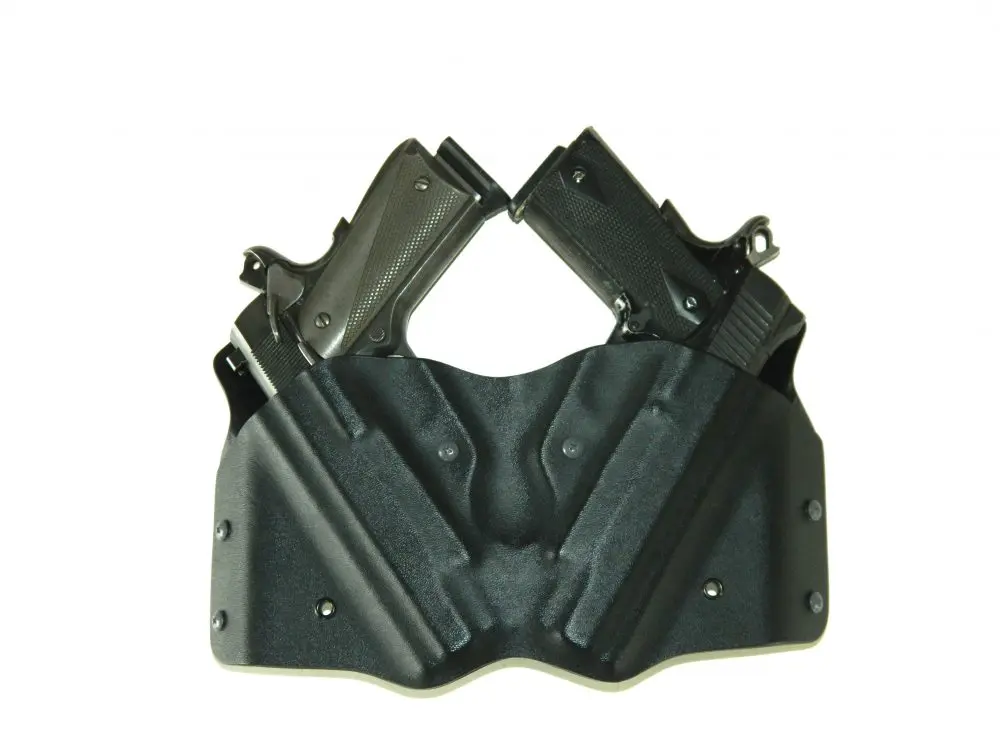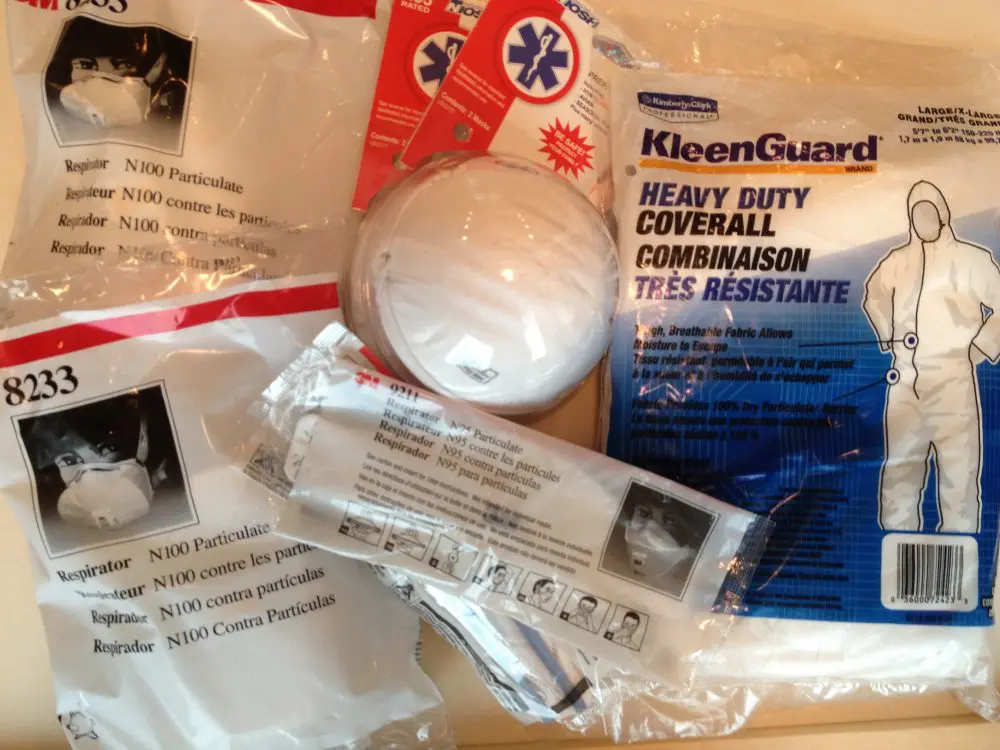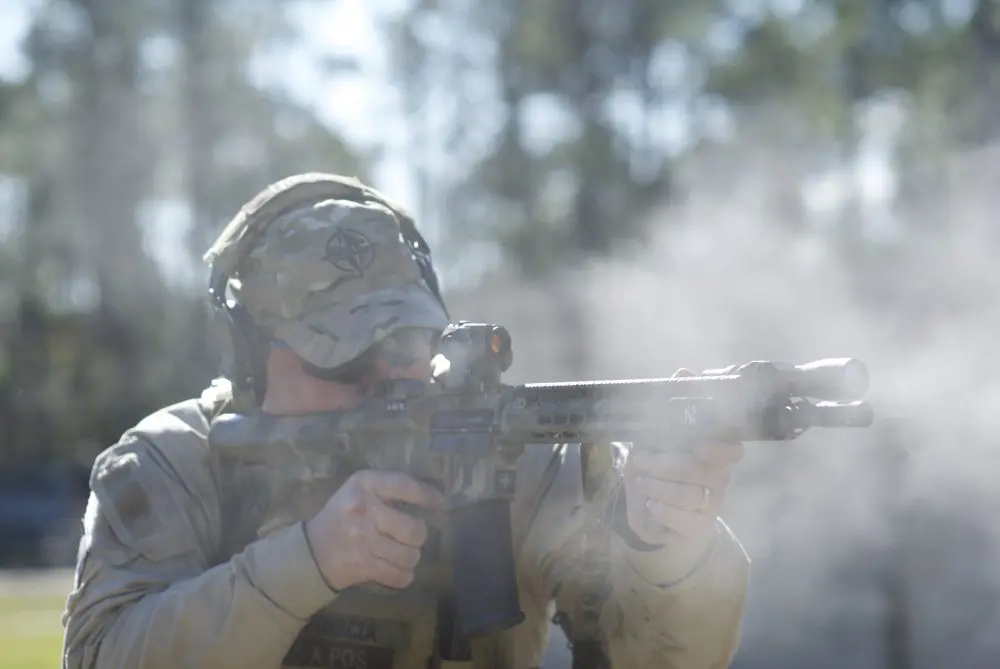Many attacks happen while the victim is in the car. Having your firearm accessible and being able to get to it quickly are important considerations in your concealed carry training. Some holsters restrict access to weapons when sitting. Practice is the time to sort this out.
Two of the things that cannot be foreseen in preparing for a lethal attack are where it is going to happen and what the threat is going to look like. Once the threat is perceived, we decide on the course of action, hope it is the correct action, and then proceed through the threat, calling on our training to guide us.
Regarding what the threat may look like, while it is impossible to read the mind of a person who is walking toward us, we might jump into Condition Orange because of his non-verbal communication or how he is carrying himself. As to where, we know there are likely places an attack can occur, and watching the evening news can often reveal a pattern as to where crime is occurring in a community.
In addition to so-called gun-free zones, attacks occur in higher numbers around vehicles and in parking lots. This doesn’t mean we have to avoid parking lots, but we should be aware of the advantages and disadvantages they offer and how to maneuver around vehicles—yours and the surrounding ones.
You have a great advantage if you are already in a vehicle. The vehicle is a powerful escape tool. The easiest escape can be just driving away. Even a bad guy set on intimidating a housewife with his weapon will think twice about getting squashed with the family SUV—it at least may throw off his aim. You can bet the jury will wonder why you didn’t try this means of escape first.
Using front wheel for cover. The wheel and engine have more metal and hence better chances of stopping bullets. It is the best spot at the front of the vehicle for cover.
Sometimes driving away will not be possible. Your vehicle might be blocked by the suspect vehicle or been disabled by the suspect prior to the confrontation. (Bad guys get ideas from the movies too.) $$sentence deleted b/c it has nothing to do with this graph$$ One thing to remember is that most attacks happen so fast there might not even be time to start the car and get away. If the bad guy knows what he’s doing, he will hit you at the most inopportune time, such as just before the key goes into the ignition.
While it is hard to get practice in running over bad guys, we can practice shooting around vehicles and developing the mindset to use the things in the parking lot that provide the best cover and escape route. Before you macho guys start in on me about running away, let me explain what I mean by “escape route.” Escape route is getting out of the hot spot to a more favorable and defendable position. It puts distance between you and the threat, giving you time to more accurately evaluate and respond to it. If escape gets me out of firing my gun or helps me to be safer after I shoot, it’s not running away—it’s a sound tactic.
The first thing to decide is whether or not to stay inside the vehicle. Normally, I do not like to stay inside the vehicle. It reduces your ability to fight and defend yourself in most circumstances. On the other hand, a woman, in a parking lot with kids and groceries, who becomes aware that a bad guy is around—and gets the doors locked before the attack—might be well off to stay put and honk the horn to get attention. She can make ready with her firearm, in case things slide rapidly downhill, and start the car.
If you work with a partner or spouse, you should know what you are going to do when the bad guy strikes. Cold or inert weapons should be used for practice. The person following should not draw their weapon until the first person is out of the vehicle.
What if staying in the car is not a good option? Knowing how to get out of the vehicle with a tactical advantage, and knowing how to use the things around you, might well be the moves that save the day.
As we all know, cover is something that will hide you and offer ballistic protection. It will stop bullets. Concealment is something that will hide you but won’t necessarily protect you from bullets. Parking lots are full of cover—good cover! Underground parking lots and even high-rise lots are made from concrete and steel. Pillars and cement barriers are good things to get behind. Vehicles can offer cover, but some parts of a car will allow bullets to pass through, for example windows, some parts of doors, and fenders. Therefore, vehicles should be thought of as providing concealment and possibly cover.
Concealment is also an attribute of defense. You want to find the best cover available, but the fact that you are hiding and the bad guy has to seek you out will many times take away his ambition to get to you, especially if he thinks you are armed or more people will arrive on the scene. Getting away from the vehicle puts the attack back in your control. You have redirected his OODA Loop (Observation, Orientation, Decision, Action). You observe his actions, and his orientation in relation to attacking you. You make a decision to get out of his line of attack (orientation), causing him to reorient, breaking his loop. You now have more time to take appropriate action to get out and follow up if necessary.
In the car he knew where you were and could attack the general vicinity, similar to being in the fatal funnel of a door or hallway. Now he doesn’t know where you are, and so you have gained some advantage. Inside the vehicle, the windows make poor cover and concealment, so hopefully you have reached a spot that is better for both.
If you have to exit the opposite side of the vehicle, stay low. It gives some cover and might keep the bad guy from knowing which way you went or if you even left the vehicle.
But before you get to cover, you first have to figure out how best to exit the vehicle. How you exit the vehicle will depend on how the attack comes. You should practice attacks from each side and also attacks with two bad guys from one side and both sides. As many scenarios as you can imagine should be practiced. By reading “this happened to me” accounts, you can get ideas on how to set up practice situations. By practicing several different set-ups, you will probably alter your habits a little, to make getting out of the vehicle easier (Example: You may not put groceries on the seat next to you in case you need to get out of the vehicle that way).
The first scenario is an attack from the front driver’s side. The bad guy is not on his game today and you see him coming a mile away. You go from yellow to red in seconds—orange is a blur. It’s going down and fast—you can see he has a weapon. No time to start the car and drive away. Your kids are in the back seat. Letting him take the car is not an option.
I place a bad guy target in front of the vehicle to the left a bit and practice getting out of the car and drawing from my usual carry position. You don’t like using the door for cover, but it is the best you have at the moment. Pointing the firearm through the open window, you start with a verbal confrontation. “Get Away!” Stop!” or some other verbal challenge to give him a chance to abort, if there is time. It is a good idea to practice some sort of verbal command so you will do it naturally in real encounters. It might save you from getting into the gunfight and will help in court after the gunfight. If you have a training partner, you can finish off the exercise with a double tap to center mass or not shoot at all, depending on what your partner said the bad guy’s reaction was.
The idea of this exercise is to safely draw the weapon from your usual carry position and get out and on target without sweeping yourself or anyone else in the vehicle. This should be done with an unloaded weapon first to get the technique down.
The exercise can be modified to include two subjects coming at you at the same time. Practice shooting and moving. Practice taking the keys with you if time allows, to avoid leaving the bad guys with an escape vehicle.
Practice moving and shooting between cover. Parking lots and vehicles offer much in the way of cover. Using reactive targets keeps you shooting until the threat is down.
Two suspects may attack from both sides and I would really like to break their OODA Loop and get out and away from the vehicle. The easiest would be out the driver’s door, engaging the first subject as I exit and the second guy if necessary from over the hood. I don’t mean resting on the hood, but shooting over the hood. This gets you out of the fatal funnel and you are getting away from the vehicle, creating distance between you and the threat. Place the targets away from the vehicle so there is no chance of hitting it. You can shoot close to the vehicle in the real situation.
I practice going off to the flank in one scenario and going to the rear of the vehicle in another, keeping it between me and the second suspect if there is no other close cover. He can then be engaged in a crouched position from the back of the car. If I am working with a partner, I will set up targets for a variety of scenarios and the partner can call which targets are threats, making me respond to the situation. These are practice scenarios on stationary targets to get used to moving and shooting around vehicles. Be aware that in real life the suspects will not stand still and let you shoot them like paper targets do. They might run to get away from you, which is preferable, or they might get to cover and take you on.
If you can go to the front of the vehicle, that is preferable because the engine is better cover than an empty trunk or pickup bed. Standing at the side of the vehicle might feel safe because it is the tallest part of the car and affords higher cover, but bullets will pass though windows and doors in some spots and might get to you. Glass and shrapnel are also hazards. The wheels offer good cover. Bullets will not pass through the wheels and axles easily, and the frame also affords some protection. You might only get a shot at the suspect’s legs, but it might convince him to quit. Training to shoot around these parts of the vehicle will make you get into the best position automatically, when you don’t have time to think about technique. Establish good defensive habits on the range and they will show themselves when needed.
There may be a time when the situation makes you shoot through the open passenger window from the driver’s seat. This should be practiced before it is necessary. I have an old truck that hauls my steel targets around and I use it as a vehicle to shoot around. Some ranges have old vehicles that they use for props, but if one is careful, this can be experienced with live fire in any vehicle. Shooting a gun inside a closed space like a vehicle will expose your body and ears to extreme pressure changes and noise. Ear and eye protection are musts. In a real situation, you might be forced to shoot through the window in a rolled-up position, but this is impractical in practice. A target positioned in front of the open passenger window can be engaged from the driver’s seat. If you have to shoot through the window in a real situation, remember the glass might deflect the bullets and also slow them down and reduce their stopping effect. This is usually remedied with more bullets. Shoot until the threat is gone.
If the attack comes from the driver’s side, an option to escape might be out the passenger door. This is why my groceries go in the back seat or in the back of the truck. My wife also knows if I start coming that way, it is time to leave the vehicle. Good prior communication with your spouse and family is important with vehicle attacks. If your spouse and older kids know to get out and away from the vehicle, they have less chance of becoming hostages should the bad guy get control of the car. The attack might be some whack job having target practice at vehicles stopped at a light. If you can ascertain the attack is from the driver’s side, you might have to exit the vehicle from the opposite side and get away to other cover. If the vehicle is the target, this is a great indicator to get away from it.
You will want to draw your weapon and exit the vehicle with it going out first. Just like searching a building, you want to follow the muzzle in case there is another threat as you leave the vehicle. Lie down and slither across the seat like a snake, opening the door and pouring out like water onto the ground. Crawl to the front or back of the vehicle, farthest away from the threat. Also be aware that other vehicles might be trying to evade gunfire around you—you don’t want to get out of the way of gunfire only to get run over by another citizen.
I like to use reactive targets for the shooting while moving drills. The reaction to a center mass hit keeps me shooting until the target falls. Stationary paper or steel records the hit, but you don’t know if it was a good hit until the stage is over. When the target falls, the hit is center mass. Action Target makes paper box humanoid targets that are held up with a balloon. The balloon is at center mass or head area, whichever you set it at. When the balloon is hit, the target falls. These are inexpensive, can be shot many times and can be dressed up to look more realistic.
Another reactive target is made by Law Enforcement Targets and is a plastic humanoid target that has chipped rubber tire material at center mass and in the head. Hits anywhere but here will pass through, but the hits in center mass will knock over the target. It can also be dressed up to look more like a real opponent. It is a three-dimensional target and can be placed at angles to the shooter to give the feeling of shooting something other than a flat piece of paper. Scattering a few reactive targets in with the paper and steel puts some reality in your scenarios.
Practicing around vehicles and safely exiting vehicles under fire are vital skills for surviving attacks and should be practiced before you need them. If you think you can’t get your fat butt out of the other side of the vehicle, believe me, when the lead starts flying, you’ll get through. We had mobile computers in our patrol cars between the driver and passenger seats and, even with the gun belt and vest and other equipment like radios, I could get through, grabbing the shotgun on the way. By addressing the task prior to an emergency, you can work out obstructions.
We are all grown up and can set up targets responsibly and safely to practice these scenarios. However, it is wise to have another person around to help with safety. Practice with cold or inert weapons for the exiting, especially with partners where there is a possibility of accidentally sweeping them. Another great way to get started with a regimen of shooting around vehicles is to attend a class at one of the shooting schools that offers this sort of program. It is a safe way to get familiar with the concepts and to help you set up your own practice sessions.
[Dave Morelli is retired from the Las Vegas Metropolitan Police Department. His duties there included being a Patrol and Field Training Officer as well as a member of the LVMPD SWAT team both as an operator and sniper.]
SOURCES:
Action Target
Dept. S.W.A.T.
1281 West 220 North
Provo, UT 84601
(888) 377-8033
www.actiontarget.com
Law Enforcement Targets
Dept. S.W.A.T.
8802 West 35W Service Dr. NE
Blaine, MN 55449-6740
(800) 779-0182
www.letargets.com
